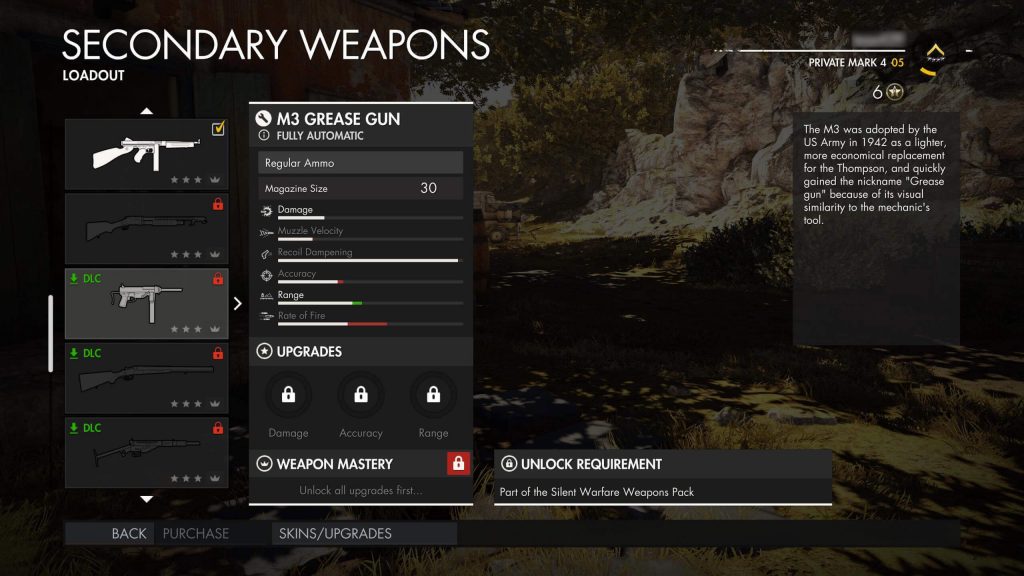Determine Whether to Disclose Rewards to Players
On this page
There are three options from which you must choose to determine how rewards will be presented to players in your game:
Let Players Know What Their Rewards Are
When players are informed about the rewards they can obtain, they are able to plan accordingly. This allows them to determine which rewards they wish to pursue and to choose optimal tactics to achieve them. Clearly presenting information about available rewards can also contribute to more streamlined and efficient gameplay.
In Sniper Elite 4, players can view the list of weapons that can be unlocked along with the specific requirements necessary to unlock them.
Credit: Rebellion Developments. Screenshot captured by the author.
Give Players Vague Clues to Find Rewards
If you choose to inform players that rewards are available for discovery, but opt not to reveal all the details—intentionally maintaining an element of mystery—this can create an engaging challenge. Clues about such rewards can be delivered through in-game elements such as letters, photographs, illustrations, maps, sound recordings, and more. When players are required to decode these clues, it introduces a new layer of gameplay that can support the following outcomes:
Improved memory of various locations within the game.
Enhanced exploration and attention to detail in each area.
This type of exploration can become even more meaningful if players are expected to revisit these locations later in the game and apply what they have learned. Consequently, finding such rewards can become particularly satisfying.
Here are several examples where players are provided with vague clues about rewards:
Example:
In Skull and Bones, players receive treasure maps containing illustrations and ambiguous instructions on how to locate treasure chests.
Example:
In S.T.A.L.K.E.R.: Call of Pripyat, players must equip themselves with an artifact detector. Early in the game, players have access to a basic model called the “Echo detector,” which only indicates the distance to an artifact through flashes and beeps. Later in the game, players may obtain the more advanced “Bear detector,” which, in addition to distance, also provides directional cues. For precise artifact location, players need to acquire either the “Veles detector” or the “Svarog detector,” both of which are only available in later stages of the game.
Example:
In Far Cry 2, when players open their map, they may notice a flashing green light on their GPS receiver. This indicates the proximity of a diamond case. As players move closer to the case, the green light flashes more rapidly. To determine the direction of the case, players must rotate until the light remains steadily illuminated.
It is essential to ensure that players do not become frustrated upon discovering that the reward does not align with their preferred playstyle or strategic choices. This concern is particularly relevant in cases where players are required to do any of the following to obtain the reward:
Spend a considerable amount of time navigating the game environment.
Progress through a substantial portion of the narrative.
Defeat numerous or particularly difficult enemies.
Solve highly complex puzzles.
Accumulate a large number of other rewards.
Repeat a specific action excessively, such as grinding.
Example:
In a role-playing game, players receive a notification of a new stash location once they acquire its coordinates. Although they are aware that a reward awaits them, the mystery of what it contains maintains their excitement. Because the stash is located far from the player’s current position, they anticipate that the journey and the associated risks will be worthwhile to discover the contents. However, upon discovering the contents of the stash, players become frustrated with what they have found. As they continue to find additional stashes containing items that are either not particularly useful or not truly worth the effort required to obtain them, they eventually lose interest in searching for more. At that point, players abandon the pursuit of stashes altogether and instead resort to looting other areas or purchasing the items they need from traders.
Make Rewards a Surprise
Any reward that players receive unexpectedly, without prior knowledge or clues, qualifies as a surprise.
Example:
In S.T.A.L.K.E.R.: Shadow of Chernobyl, many first-time players are unaware that a Gauss rifle can be obtained. Thus, they are genuinely surprised by its power when they eventually acquire it—most likely in the Sarcophagus area, where it is guarded by elite Monolith soldiers.
Even if players have some partial knowledge regarding a particular reward, they may still be surprised by its actual value or impact. Such clues may include:
A general sense of where or when the reward may be obtained.
Some understanding of the category or type of the reward.
Example:
In Company of Heroes: Blitzkrieg Mod, first-time players who select the Royal Engineers Support company during a skirmish can see an unlockable unit named “Crocodile Ace Support” in the Company Commander window. While the image clearly identifies the reward as a tank, players remain unaware of its exceptional effectiveness against enemy bunkers, anti-tank gun crews, and infantry until they deploy it in gameplay.

